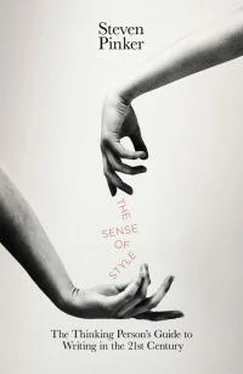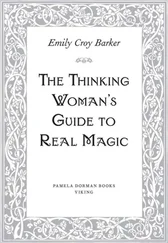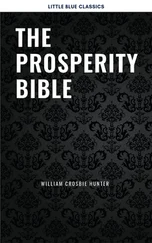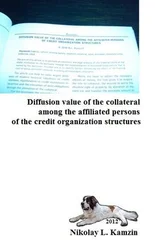7. M. Fox, “Maurice Sendak, author of splendid nightmares, dies at 83,” New York Times, May 8, 2012; “Pauline Phillips, flinty adviser to millions as Dear Abby, dies at 94,” New York Times, Jan. 17, 2013; “Helen Gurley Brown, who gave ‘Single Girl’ a life in full, dies at 90,” New York Times, Aug. 13, 2013. I have altered the punctuation to conform to the style of this book, and in the Phillips excerpt I have quoted two of the four “Dear Abby” letters in the original obituary and reordered them.
8. Poole et al., 2011.
9. McNamara, Crossley, & McCarthy, 2010; Poole et al., 2011.
10. Pinker, 2007, chap. 6.
11. M. Fox, “Mike McGrady, known for a literary hoax, dies at 78,” New York Times, May 14, 2012.
12. I. Wilkerson, The warmth of other suns: The epic story of America’s great migration ( New York: Vintage, 2011), pp. 8–9, 14–15.
CHAPTER 2: A WINDOW ONTO THE WORLD
1. Versions of this saying have been expressed by the writing scholar James C. Raymond, the psychologist Philip Gough, the literary scholar Betsy Draine, and the poet Mary Ruefle.
2. For a discussion of the ubiquity of concrete metaphors in language, see Pinker, 2007, chap. 5.
3. Grice, 1975; Pinker, 2007, chap. 8.
4. Thomas & Turner, 1994, p. 81.
5. Thomas & Turner, 1994, p. 77.
6. Both quotations are from p. 79.
7. B. Greene, “Welcome to the multiverse,” Newseek / The Daily Beast, May 21, 2012.
8. D. Dutton, “Language crimes: A lesson in how not to write, courtesy of the professoriate,” Wall Street Journal, Feb. 5, 1999, http://denisdutton.com/bad_writing.htm.
9. Thomas & Turner, 1994, p. 60.
10. Thomas & Turner, 1994, p. 40.
11. Most likely said by the Kansas newspaper editor William Allen White, http://quoteinvestigator.com/2012/08/29/substitute-damn/.
12. “Avoid clichés like the plague” is one of the many self-undermining rules of writing popularized by William Safire in his 1990 book Fumblerules. The genre goes back at least to 1970s campus xeroxlore; see http://alt-usage-english.org/humorousrules.html.
13. Keysar et al., 2000; Pinker, 2007, chap. 5.
14. From the historian Niall Ferguson.
15. From the linguist Geoffrey Pullum.
16. From the politician, lawyer, executive, and immortal Montreal Canadiens goaltender Ken Dryden.
17. From the historian Anthony Pagden.
18. The Dickens simile is from David Copperfield.
19. Roger Brown, in an unpublished paper.
20. A. Bellow, “Skin in the game: A conservative chronicle,” World Affairs, Summer 2008.
21. H. Sword, “Zombie nouns,” New York Times, July 23, 2012.
22. G. Allport, “Epistle to thesis writers,” photocopy handed down by generations of Harvard psychology graduate students, undated but presumably from the 1960s.
23. From the Pennsylvania Plain Language Consumer Contract Act, http://www.pacode.com/secure/data/037/chapter307/s307.10.html.
24. G. K. Pullum, “The BBC enlightens us on passives,” Language Log, Feb. 22, 2011, http://languagelog.ldc.upenn.edu/nll/?p=2990.
CHAPTER 3: THE CURSE OF KNOWLEDGE
1. Sword, 2012.
2. Named after Robert J. Hanlon, who contributed it to Arthur Bloch’s Murphy’s Law Book Two: More reasons why things go wrong! (Los Angeles: Price/Stern/Sloan, 1980).
3. The term “curse of knowledge” was coined by Robin Hogarth and popularized by Camerer, Lowenstein, & Weber, 1989.
4. Piaget & Inhelder, 1956.
5. Fischhoff, 1975.
6. Ross, Greene, & House, 1977.
7. Keysar, 1994.
8. Wimmer & Perner, 1983.
9. Birch & Bloom, 2007.
10. Hayes & Bajzek, 2008; Nickerson, Baddeley, & Freeman, 1986.
11. Kelley & Jacoby, 1996.
12. Hinds, 1999.
13. Other researchers who have made this suggestion include John Hayes, Karen Schriver, and Pamela Hinds.
14. Cushing, 1994.
15. From the title of the 1943 style manual by Robert Graves and Alan Hodge, The reader over your shoulder: A handbook for writers of prose (New York: Random House; revised edition, 1979).
16. Epley, 2014.
17. Fischhoff, 1975; Hinds, 1999; Schriver, 2012.
18. Kelley & Jacoby, 1996.
19. Freedman, 2007, p. 22.
20. From p. 73 of the second edition (1972).
21. Attentive readers may notice that this definition of syllepsis is similar to the definition of zeugma I gave in connection with the Sendak obituary in chapter 1. The experts on rhetorical tropes don’t have a consistent explanation of how they differ.
22. G. A. Miller, 1956.
23. Pinker, 2013.
24. Duncker, 1945.
25. Sadoski, 1998; Sadoski, Goetz, & Fritz, 1993; Kosslyn, Thompson, & Ganis, 2006.
26. Schriver, 2012.
27. Epley, 2014.
CHAPTER 4: THE WEB, THE TREE, AND THE STRING
1. Florey, 2006.
2. Pinker, 1997.
3. Pinker, 1994, chap. 4.
4. Pinker, 1994, chap. 8.
5. I use the analyses in The Cambridge Grammar of the English Language (Huddleston & Pullum, 2002) with a few simplifications, including those introduced in the companion A Student’s Introduction to English Grammar (Huddleston & Pullum, 2005).
6. The incident is described in Liberman & Pullum, 2006.
7. Huddleston & Pullum, 2002; Huddleston & Pullum, 2005.
8. Bock & Miller, 1991.
9. Chomsky, 1965; see Pinker, 1994, chaps. 4 and 7.
10. Pinker, 1994, chap. 7. For more recent reviews of the experimental study of sentence processing, see Wolf & Gibson, 2003; Gibson, 1998; Levy, 2008; Pickering & van Gompel, 2006.
11. From Liberman & Pullum, 2006.
12. Mostly from the column of Aug. 6, 2013.
13. I have simplified the tree on page 100; the Cambridge Grammar would call for two additional levels of embedding in the clause Did Henry kiss whom to represent the inversion of the subject and the auxiliary.
14. The first example is from the New York Times “After Deadline” column; the second, from Bernstein, 1965.
15. Pinker, 1994; Wolf & Gibson, 2003.
16. Some of the examples come from Smith, 2001.
17. R. N. Goldstein, 36 Arguments for the existence of God: A work of fiction (New York: Pantheon, 2010), pp. 18–19.
18. From “Types of sentence branching,” Report writing at the World Bank, 2012, http://colelearning.net/rw_wb/module6/page7.html.
19. Here and elsewhere, I use the label Noun Phrase for the constituent the Cambridge Grammar calls “Nominal.”
20. Zwicky et al., 1971/1992. See also http://itre.cis.upenn.edu/~myl/langua gelog/archives/001086.html.
21. Pinker, 1994, chap. 4; Gibson, 1998.
22. Boston Globe, May 23, 1999.
23. Fodor, 2002a, 2002b; Rayner & Pollatsek, 1989; Van Orden, Johnston, & Hale, 1988.
24. R. Rosenbaum, “Sex week at Yale,” Atlantic Monthly, Jan./Feb. 2003; reprinted in Pinker, 2004.
25. The unattributed source for most of these emails is Lederer, 1987.
26. Spotted by Language Log, http://languagelog.ldc.upenn.edu/nll/?p=4401.
27. Bever, 1970.
28. Pinker, 1994, chap. 7; Fodor, 2002a; Gibson, 1998; Levy, 2008; Pickering & van Gompel, 2006; Wolf & Gibson, 2003.
29. Nunberg, 1990; Nunberg, Briscoe, & Huddleston, 2002.
30. Levy, 2008.
31. Pickering & Ferreira, 2008.
32. Cooper & Ross, 1975; Pinker & Birdsong, 1979.
33. The example is from Geoffrey Pullum.
34. Gordon & Lowder, 2012.
35. Huddleston & Pullum, 2002; Huddleston & Pullum, 2005.
CHAPTER 5: ARCS OF COHERENCE
1. Mostly from Lederer, 1987.
2. Wolf & Gibson, 2006.
3. Bransford & Johnson, 1972.
4. M. O’Connor, “Surviving winter: Heron,” The Cape Codder, Feb. 28, 2003; reprinted in Pinker, 2004.
Читать дальше












